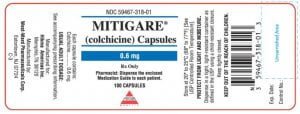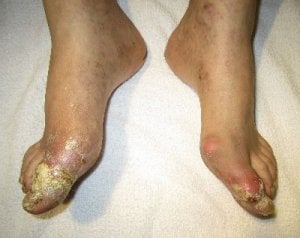Uric acid level is the most important number you must know to be able to manage your gout.
Rather than a single number, you really need to think of a range.
Your uric acid level will fluctuate naturally during the day, and other factors can also cause temporary changes.
The best advice for gout sufferers is never let blood uric acid concentration rise above 5 mg/dL (0.30mmol/L) [1]. But does this mean you should worry if it falls below, or rises slightly above? How precise does it have to be?
We know from the gout and lifestyle articles that high purine meals and strenuous exercise can temporarily raise uric acid levels. In testing blood uric acid, these variations can often be avoided, but others are not so obvious.
In particular, it is known that uric acid level fluctuates naturally through the day. We have known for a long time that uric acid excretion is higher at night [2-3]. Though interesting, this is not truly helpful, as it is the uric acid level of blood that determines the risk of gout attacks.
More recent analysis tells us that uric acid production also increases at night, though no explanation is offered. This means that uric acid is generally higher after sleep, though only around 0.5 mg/dL (0.03mmol/L).
The natural daily fluctuation in uric acid levels means that the exact figure from your test result, though vitally important, may not tell the full story. A small difference up or down should not cause alarm, and it is best to look at the average of a few results for a clearer picture.
The other significant factor is the stage of your gout treatment program. During the first year or so, most gout patients will benefit from a significantly lower uric acid level. This allows uric acid crystals to dissolve quicker – see the Gout Treatment pages for more details, or search for faster lower in the search box at the top of each page.

Uric Acid Level: Next Steps
You have learned that your maximum uric acid level should be in the range 5-6 mg/dL (0.30-0.35 mmol/L), though lower is even better.
Read all the pages in this Uric Acid section to get the fullest understanding of uric acid and gout.
If you continue to be confused by uric acid, you should discuss it with other gout sufferers.
Leave How Your Uric Acid Level Changes to browse the Uric Acid guidelines
Uric Acid Level Change Related Topics
Please remember: to find more related pages that are relevant to you, use the search box near the top of every page.
Common Terms: Most Helpful Gout Pages, result, Uric Acid Levels
Other posts that include these terms:
- High Alkaline Foods for Gout Diet Menu
- Gout Foods Table for Vegetables
- Gout Food List for GoutPal Foodies
- Foods High in Uric Acid Chart
- Purine Rich Foods
- Does Alcohol Affect Gout?
- Colchicine For Gout
Uric Acid Level References
- Jordan, Kelsey M., J. Stewart Cameron, Michael Snaith, Weiya Zhang, Michael Doherty, Jonathan Seckl, Aroon Hingorani, Richard Jaques, and George Nuki. “British Society for Rheumatology and British Health Professionals in Rheumatology guideline for the management of gout.” Rheumatology 46, no. 8 (2007): 1372-1374. UK Gout Management Recommendations PDF.
- Leathes, J. B. “On diurnal and nocturnal variations in the excretion of uric acid.” The Journal of physiology 35.1-2 (1906): 125-130. Day-Night Uric Acid Variations PDF.
- Owen-Smith, B. D. “Significance of circadian variations of uric acid elimination.” Annals of the rheumatic diseases 42.Suppl 1 (1983): 87. Daily Uric Acid Variations PDF.
Please give your feedback
Did this page help you? If yes, please consider a small donation. Your donations help keep GoutPal's gout support services free for everyone.
If not, please tell me how I can improve it to help you more.
- YouTube
- The gout forums.








